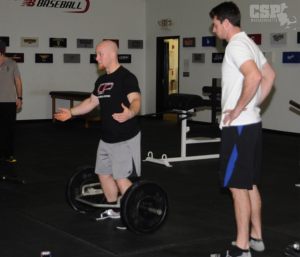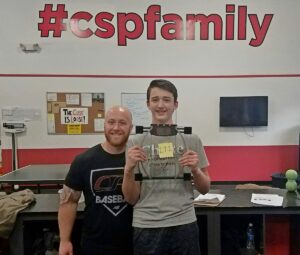
5 Reasons You Can’t Train High School Athletes Like Pros
Today’s guest post comes from Cressey Sports Performance coach, Tony Bonvechio.
Like many strength and conditioning coaches, I entered the fitness industry thinking I wanted to train professional athletes. I’m lucky that I get to do exactly that on a daily basis, but I quickly discovered that some of the most rewarding coaching experiences have come from training high school athletes.
Sure, watching your clients play on TV is awesome, but your potential to help a younger, less established athlete can reach far beyond the field of play. Bumping a big leaguer’s fastball from 92mph to 95mph might help him land a bigger contract, but helping a 9th grader make the junior varsity team can build confidence and self esteem that is literally life changing.
That said, high schoolers and professionals have drastically different training needs. This sounds obvious, but you’d be surprised how many coaches promise the world to high school athletes by helping them “train like the pros,” only to see minimal results. Here are five reasons you can’t train little Johnny or Jane like their favorite pro athletes, even if it seems like good marketing:
1. They’re Not Strong Enough for Fancy Stuff Yet
Athletes ages 13-18 comes in all shapes, sizes and strength levels. Some look like babies while others look like they’re ready for the NFL combine, but most fall into the former category. These athletes usually struggle to perform elementary movements like squats, push-ups and lunges. They’ve got no business working on fancy change of direction drills or contrast training protocols until they’ve mastered the basics.
“Just get strong” is a common strength coach copout, but in this case it has merit. As my fellow CSP coach Greg Robins often says, think of athletic potential as a pool of water. The stronger the athlete, the more water they have in the pool. The more powerful the athlete, the faster they can draw water out of that pool. While power is of utmost importance for team sports, if your pool of water is shallow, it doesn’t matter how fast you draw it out. Strength is still the foundation of most athletic qualities, making it the most trainable quality for young athletes.
It’s certainly possible for a pro athlete to be “strong enough” to the point where they won’t improve much athletically by adding 50 pounds to their deadlift, but for a younger athlete, that might be exactly what he or she needs before they can cash in on more advanced training methods.
2. They Need Less Loading for the Same Strength Gains
Novice trainees can get stronger with as little as 40-50% of their 1-rep max. On the other hand, more experienced lifters need a ton of submaximal volume and frequent exposures to heavy training loads (above 90 percent of 1RM) to keep gaining strength. And while not every pro athlete is an experienced lifter, they’ll likely have more training experience than a high school athlete.
What’s the point?
[bctt tweet=”Teenagers get strong without much work. Don’t test 1RMs when you can gain with lighter weights.”]
3. They (Hopefully) Play Multiple Sports
Young athletes have the opportunity to play multiple sports during the year, while virtually no pro athletes do that anymore. The days of Bo Jackson and Deion Sanders are long gone, so while the pros get to focus on the specific physical demands of their sport year round, high schoolers are likely playing several sports with drastically different requirements in terms of strength, power and endurance.
What happens if we have a high school athlete who plays football in the fall, basketball in the winter and baseball in the spring? There’s no defined off-season, making periodization much trickier. A pro baseball pitcher may not pick up a baseball from October to January, but for someone who constantly has games and practices, you can’t block training into specific physical qualities. A concurrent training approach (i.e. training endurance, strength and power all at once) or “concurrent with emphasis” (where you prioritize endurance, strength or power but touch upon the others to preserve them) becomes a necessity.
What about exercise selection? We know the bench press is great for football, but not ideal for baseball. We know distance running doesn’t do much for baseball, but may have merit for basketball. And what if he or she plays two sports at once (i.e. AAU basketball overlapping the other two high school seasons)? We can no longer speak in absolutes or make generalized exercise contraindications when it comes to developing a well-rounded athlete.
Yes, more young athletes are specializing at a younger age. We can do our part by influencing them to play multiple sports as long as possible, but we can also design well-rounded programs that expose them to dormant movement patterns and untapped strength qualities rather than always being laser focused on training for their primary sport.
4. There are Too Many Cooks in the Kitchen
When too many cooks contribute to one dish, it won’t taste good. With high school athletes, you’ve got a lot of cooks (i.e. influences) in their kitchen (i.e. athletic career), making it difficult to create a cohesive dish worth tasting. It’s our job as the strength and conditioning coach to be the objective taste tester and adjust overall training stress to optimize performance.
Parents, teachers, coaches and friends influence every move an athlete makes on and off the field. It’s tough to get everyone on the same page. It’s common to hear an athlete say their coach wants them to get faster, their parents wants them to get more flexible and their teachers want them to study more and work out less. Who’s a teenager supposed to listen to?
In this case, it comes down to asking the right questions. I’ve learned that just by asking how an athlete is doing outside the gym can unveil the bigger picture. I’ve had a baseball player confess to performing upwards of four extra workouts a week because they’re participating in off-season training with the football team, all while getting less than five hours of sleep while studying for exams. This athlete is far from ready to hit in hard in the gym and it’s my job to adjust his training.
[bctt tweet=”Ignorance is NOT bliss as the strength coach; keep tabs on ALL stressors in an athlete’s life.”] Ask questions and get to know how an athlete’s lifestyle can affect their performance.
5. They Have Lackluster Recovery
Piggybacking on the last point, most high school athletes don’t recover from training as if their sport was their job. And that’s because it’s not. While most pro athletes are unrecovered too (they’re essentially third-shift workers with insane travel schedules), high school athletes don’t have a paycheck riding on their performance. So they stay up too late, eat Doritos and Skittles for lunch and don’t think twice about it.

Great athletes live and die by their routines. Pro athletes especially settle into a daily routine that makes them feel ready to compete, from showing up to the field or court at the same time every day, to eating specific meals, to wearing the same sweaty socks for every game. A high school athlete may fly by the seat of his or her pants unless told otherwise, so we can guide them toward a routine that includes quality training, nutrition and sleep.
Take the time to educate your young athletes on the importance of simple recovery methods like foam rolling, eating enough protein and getting to bed before 10 p.m. They may not appreciate it immediately, but once they feel the difference in physical and mental performance, they’ll be more likely to recover like it’s their job.
Conclusion
It’s tempting to use aggressive loading and exotic exercise selection with young athletes, but they rarely need either of them. The basics work for a reason and you’ll see success with surprisingly simple protocols if coached and performed diligently.




